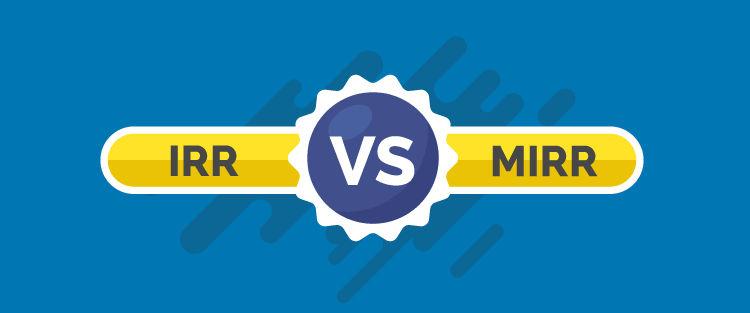Modified Internal Rate of Return (MIRR)

How MIRR is different from IRR
Modified internal rate of return is a calculation of the return from a project, with an assumption that cash flows earned from a project shall be reinvested to earn a return equal to the company’s cost of capital (Ke) and not IRR. Therefore, in the example of the project with an NPV of Rs.500,000 at a cost of capital (Ke) of 10%, MIRR would be calculated with the assumption that project cash flows are reinvested at a return of 10% per year (which is company cost of capital ke) and not at 15% which is the IRR.
An Assumption for calculating IRR is that all cash flows earned by the project can be reinvested to earn a return equal to the IRR.
Suppose that a project has an NPV of + Rs.500,000 when discounted at the cost of capital of 10%, and the IRR of the project is 15%. In calculating the IRR, an assumption would be all cash flows from the project shall be reinvested when they are received to earn a return of 15% which is IRR no matter the company’s cost of capital (Ke) is 10%.
MIRR is more realistic because it is based on the cost of capital as the investment rate and not IRR.
How to calculate MIRR
Below is the complete approach for calculating MIRR.
Step 1:
Calculate the Present Value (PV) of cash flow during investment phase, If there is negative cash flow in year 1 or year 2, discount them to year zero and include in the investment phase.
Step 2:
Take the cash flow from the year the project starts positive present value (PV) and compound them till the year which is end of the project, use cost of capital (Ke) for compounding.
For example, if there is 5 year project now from year 2 PV is positive so compound from Year 2 to Year 5 using cost of capital. For year 3 compound from Year 3 to Year 5 and so on.
Step 3:
Calculate MIRR by using below formula:
Where:
n = Project Life
A = end of the year investment returns calculated in step 2
B = present value of capital invested in step 1
Example: Modified Internal Rate of Return (MIRR)
A project requires minimum expected rate of return of 10%, project life is 5 years, the expected cash flows of the projects are as follows:
| Year | Cash Flow | Discount factor 10% | Present Value |
| 0 | (90,000) | 1 | (90,000) |
| 1 | (20,000) | 0.909 | (18,180) |
| 2 | 60,000 | 0.826 | 49,560 |
| 3 | 70,000 | 0.751 | 52,570 |
| 4 | 40,000 | 0.683 | 27,320 |
| 5 | (15,000) | 0.621 | (9,315) |
| NPV | 11,955 |
Answer:
Step 1: Present Value at investment phase, negative discounted cash flows at year 1 are taken in investment phase as per step 1 guidelines.
| Year | Cash Flow | Discount factor 10% | Present Value |
| 0 | (90,000) | 1 | (90,000) |
| 1 | (20,000) | 0.909 | (18,180) |
| 108,180 |
Step 2: Reinvest cash flow in the recovery phase at the cost of capital of 10%.
|
Year |
Cash Flow |
Compound at 10% |
Present Value |
|
2 |
60,000 |
(1.1) 3 |
79,860 |
|
3 |
70,000 |
(1.1) 2 |
84,700 |
|
4 |
40,000 |
(1.1) 1 |
44,000 |
|
5 |
(15,000) |
|
(15,000) |
|
NPV |
|
|
193,560 |
Step 3: Calculate using MIRR formula.
Related Article:







No Comments